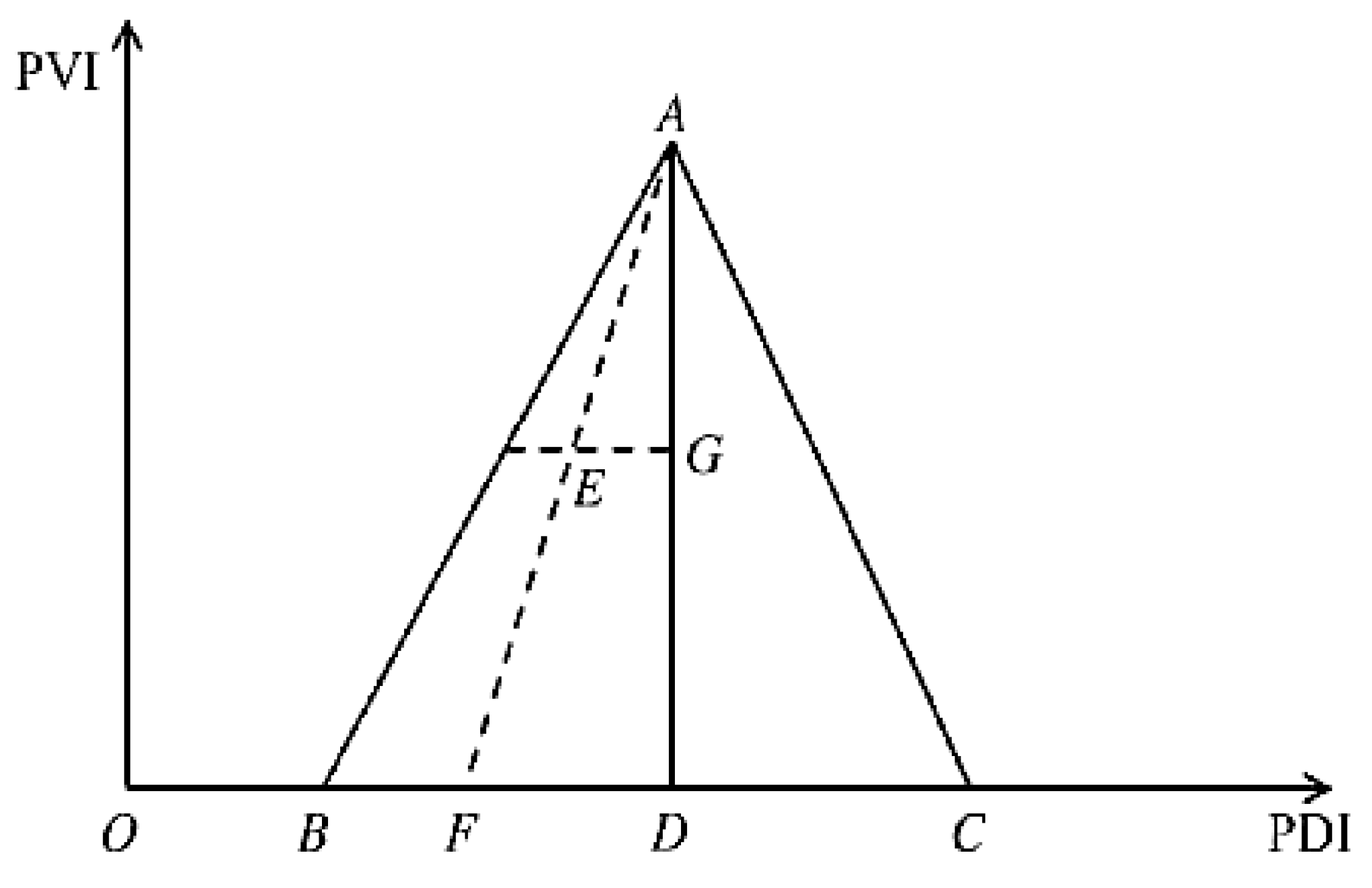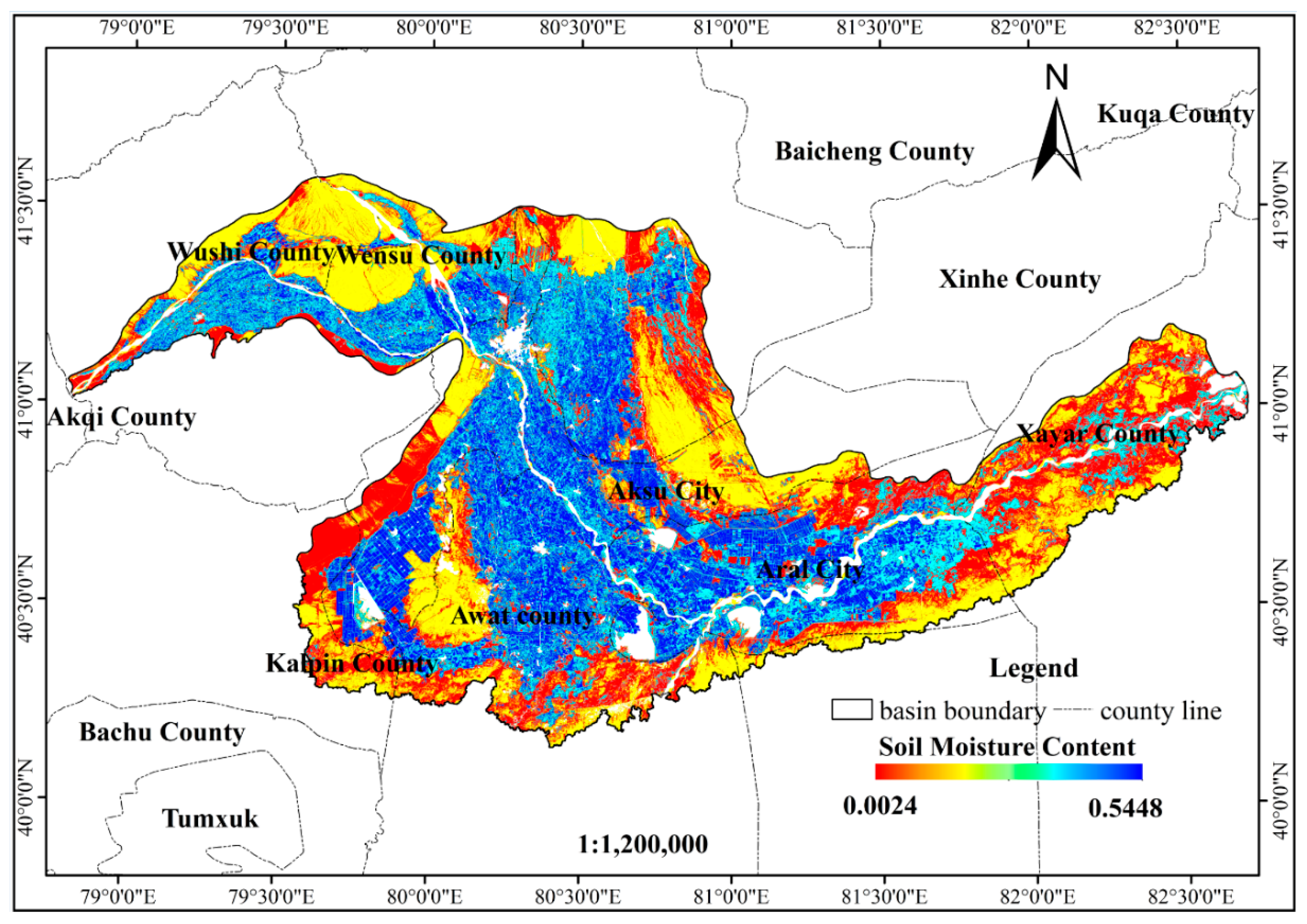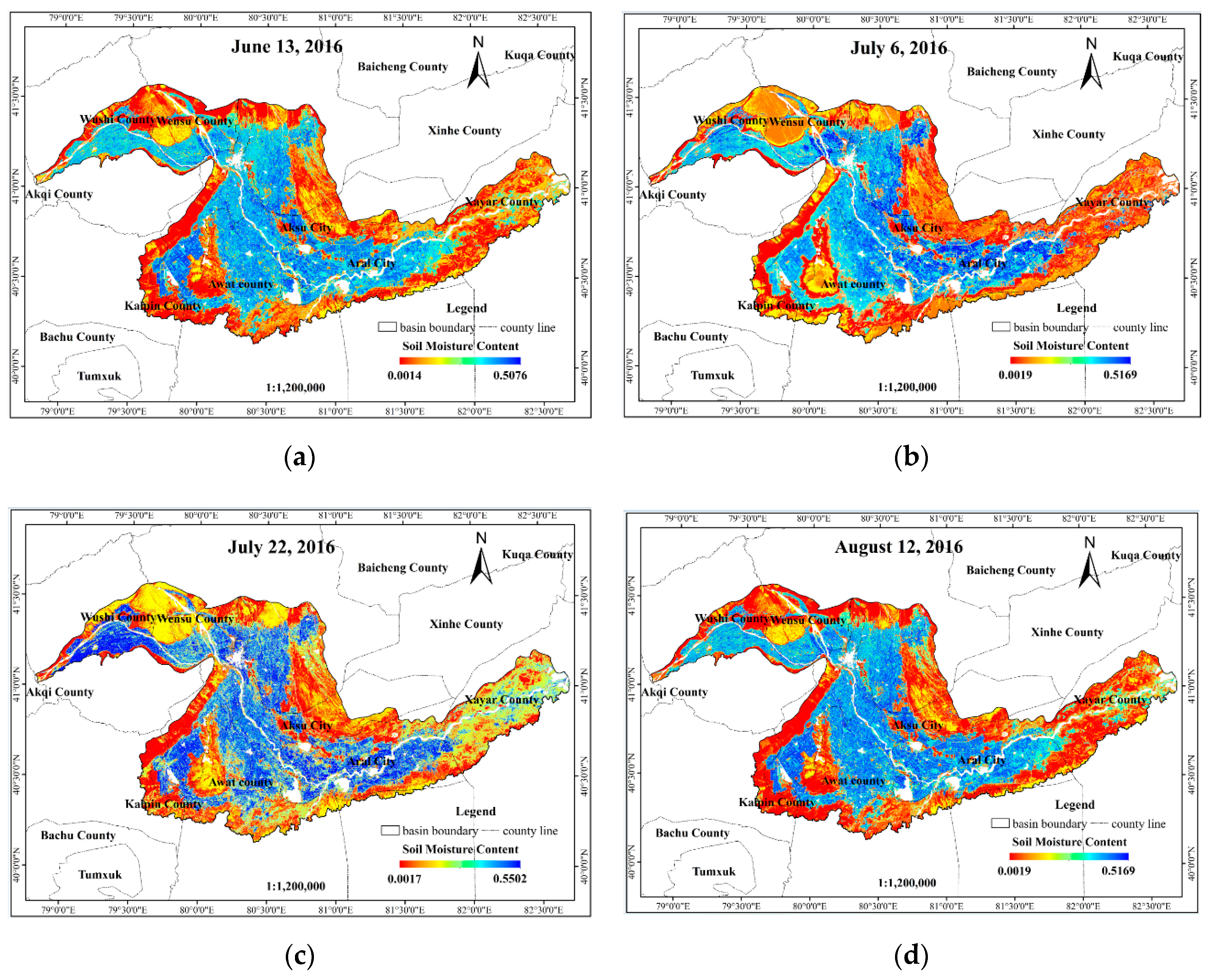Suitability Evaluation of Typical Drought Index in Soil Moisture Retrieval and Monitoring Based on Optical Images
Abstract
1. Introduction
2. Materials and Methods
2.1. Study Area
2.2. Data Acquisition and Processing
2.3. Data Analysis Methods
2.3.1. Perpendicular Drought Index (PDI)
2.3.2. Modified Perpendicular Drought Index (MPDI)
2.3.3. Vegetation-Adjusted Perpendicular Drought Index (VAPDI)
3. Results and Analysis
3.1. Construction of Soil Moisture Inversion Models
3.1.1. Descriptive Statistics of Measured Soil Moisture Data
3.1.2. Construction of Soil Moisture Inversion Models
3.2. Discussion of the Inversion Model Results
3.2.1. Analysis of the Inversion Models
3.2.2. Accuracy of the Inversion Models
3.3. Inversion and Time Dependent Monitoring of Surface Soil Moisture
3.3.1. Analysis of Surface Soil Moisture Inversion Results
3.3.2. Monitoring Surface Soil Moisture through Time
4. Discussion
5. Conclusions
Author Contributions
Funding
Conflicts of Interest
References
- Koster, R.D.; Yamada, T. Regions of Strong Coupling between Soil Moisture and Precipitation. Science 2004, 305, 1138–1140. [Google Scholar] [CrossRef]
- Jin, H.; Zhu, Q.; Zhao, X.; Zhang, Y. Simulation and Prediction of Climate Variability and Assessment of the Response of Water Resources in a Typical Watershed in China. Water 2016, 8, 490. [Google Scholar] [CrossRef]
- Zhang, L.; Lu, H.Q.; Wang, L.Y.; Yang, B.Y. Spatial-temporal Characteristics of Soil Moisture in China. Acta Geo. Sinica 2016, 71, 1494–1508. (In Chinese) [Google Scholar]
- Meyer, T.; Weihermüller, L.; Vereecken, H.; Jonard, F. Vegetation Optical Depth and Soil Moisture Retrieved from L-Band Radiometry over the Growth Cycle of a Winter Wheat. Remote Sens. 2018, 10, 1637. [Google Scholar] [CrossRef]
- Thevs, N.; Peng, H.Y.; Rozi, A.; Zerbe, S.; Abdusalih, N. Water Allocation and Water Consumption of Irrigated Agriculture and Natural Vegetation in the Aksu-Tarim River Basin, Xinjiang, China. J. Arid Environ. 2015, 112, 87–97. [Google Scholar] [CrossRef]
- Yang, P.; Xia, J.; Zhan, C.S.; Mo, X.G.; Chen, X.J.; Hu, S.; Chen, J. Estimation of Water Consumption for Ecosystems based on Vegetation Interfaces Processes Model: A case study of the Aksu River Basin, Northwest China. Sci. Total Environ. 2018, 613, 186–195. [Google Scholar] [CrossRef]
- George, P.P.; Gareth, I.; Brian, B. Surface Soil Moisture Retrievals from Remote Sensing: Current Status, Products and Future Trends. Phys. Chem. Earth 2015, 83, 36–56. [Google Scholar]
- Verstraeten, W.W.; Veroustraete, F.; Sande, C.J.; Grootaers, L.; Feyen, J. Soil Moisture Retrieval using Thermal Inertia, Determined with Visible and Thermal Spaceborne Data, Validated for European Forests. Remote Sens. Environ. 2006, 101, 299–314. [Google Scholar] [CrossRef]
- Karthikeyan, L.; Pan, M.; Wanders, N.; Kumar, D.N.; Wood, E.F. Four Decades of Microwave Satellite Soil Moisture Observations: Part 1. A Review of Retrieval Algorithms. Adv. Water Resour. 2017, 109, 106–120. [Google Scholar] [CrossRef]
- Rijal, S.; Zhang, X.; Jia, X. Estimating Surface Soil Water Content in the Red River Valley of the North using Landsat 5 TM Data. Soil Sci. Soc. Am. J. 2013, 77, 1133–1143. [Google Scholar] [CrossRef]
- Njoku, E.G.; Jackson, T.J.; Lakshmi, V.; Chan, T.K.; Nghiem, S.V. Soil Water Content Retrieval from AMSR-E. IEEE Trans. Geosci. Remote Sens. 2003, 41, 215–229. [Google Scholar] [CrossRef]
- Kerr, Y.H.; Waldteufel, P.; Wigneron, J.P.; Martinuzzi, J.M.; Font, J.; Berger, M. Soil Water Content Retrieval from Space: The Soil Water Content and Ocean Salinity (SMOS) Mission. IEEE Trans. Geosci. Rem. Sens. 2001, 39, 1729–1735. [Google Scholar] [CrossRef]
- Jaward, A.B.; Ayman, S.; Aaron, B. A Comparison of Two Models to Predict Soil Moisture from Remote Sensing Data of RADARSAT II. Arab. J. Geosci. 2014, 7, 4851–4860. [Google Scholar]
- Chai, X.; Zhang, T.; Shao, Y.; Gong, H.; Liu, L.; Xie, K. Modeling and Mapping Soil Moisture of Plateau Pasture Using RADARSAT-2 Imagery. Remote Sens. 2015, 7, 1279. [Google Scholar] [CrossRef]
- Moran, M.S.; Peters-Lidard, C.D.; Watts, J.M.; McElroy, S. Estimating Soil Water Content at the Watershed Scale with Satellite-based Radar and Land Surface Models. Can. J. Rem. Sens. 2004, 30, 805–826. [Google Scholar] [CrossRef]
- Pratola, C.; Barrett, B.; Gruber, A.; Dwyer, E. Quality Assessment of the CCI ECV Soil Moisture Product Using ENVISAT ASARWide Swath Data over Spain, Ireland and Finland. Remote Sens. 2015, 7, 5388. [Google Scholar] [CrossRef]
- Parinaz, R.B.; Kenji, O.; Yo, S. Comparative Evaluation of the Vegetation Dryness Index(VDI), the Temperature Vegetation Dryness Index(TVDI) and the Improved TVDI (iTVDI) for Water Stress Detection in Semi-arid Regions of Iran. ISPRS J. Photogramm. Remote Sens. 2012, 68, 1–12. [Google Scholar]
- Liu, L.Y.; Liao, J.S.; Chen, X.Z. The Microwave Temperature Vegetation Drought Index(MTVDI) based on AMSR-E Brightness Temperatures for Long-term Drought Assessment Across China (2003–2010). Remote Sens. Environ. 2017, 199, 302–320. [Google Scholar] [CrossRef]
- Wu, C.L.; Qin, Q.M.; Li, M.; Zhang, N. Soil Moisture Monitoring of Vegetative Area in Farmland by Remote Sensing based on Spectral Feature Space. Trans. Chin. Soc. Agr. Eng. 2014, 30, 106–112. (In Chinese) [Google Scholar]
- Richardson, A.J.; Wiegand, C.L. Distinguishing Vegetation from Soil Background Information. Photogramm. Eng. Remote Sens. 1977, 43, 1541–1552. [Google Scholar]
- Ghulam, A.; Qin, Q.M.; Zhan, Z.M. Designing of the Perpendicular Drought Index. Environ. Geol. 2007, 52, 1045–1052. [Google Scholar] [CrossRef]
- Brosinsky, A.; Lausch, A.; Doktor, D.; Salbach, C.; Merbach, I. Analysis of Spectral Vegetation Signal Characteristics as a Function of Soil Moisture Conditions using Hyperspectral Remote Sensing. J. Indian Soc. Remote Sens. 2014, 42, 311–324. [Google Scholar] [CrossRef]
- Gao, Z.L.; Zheng, X.P.; Scun, Y.J.; Wang, J.H. A Novel Method of Soil Moisture Content Monitoring by Land Surface Temperature and LAI. Spectrosc. Spect. Anal. 2015, 35, 3129–3133. [Google Scholar]
- Wang, H.Q.; Magagi, R.; Goita, K. Comparison of Different Polarimetric Decompositions for Soil Moisture Retrieval over Vegetation Covered Agricultural Area. Remote Sens. Environ. 2017, 199, 120–136. [Google Scholar] [CrossRef]
- Rahman, M.S.; Di, L.; Yu, E.; Lin, L.; Zhang, C.; Tang, J. Rapid Flood Progress Monitoring in Cropland with NASA SMAP. Remote Sens. 2019, 11, 191. [Google Scholar] [CrossRef]
- Liang, S. An Investigation of Remotely-sensed Soil Depth on the Optical Region. Int. J. Remote Sens. 1997, 18, 3395–3408. [Google Scholar] [CrossRef]
- Calvet, J.C.; Noilhan, J. From Near-surface to Root-zone Soil Moisture using Year-round Data. J. Hydrometeorol. 2000, 1, 393–411. [Google Scholar] [CrossRef]
- Sergio, S.R.; María, P.; Nilda, S.; José, M.F. Combining SMOS with Visible and Near/shortwave/thermal Infrared Satellite Data for High Resolution Soil Moisture Estimates. J. Hydrol. 2014, 516, 273–283. [Google Scholar]
- Sujay, V.K.; Paul, A.D.; Christa, D.P.; Rajat, B.; John, B. Information Theoretic Evaluation of Satellite Soil Moisture Retrievals. Remote Sens. Environ. 2018, 204, 392–400. [Google Scholar]
- Zhou, Q.B.; Yu, Q.Y.; Liu, J.; Wu, W.B.; Tang, H.J. Perspective of Chinese GF-1 High-resolution Satellite Data in Agricultural Remote Sensing Monitoring. J. Integr. Agr. 2017, 16, 242–251. [Google Scholar] [CrossRef]
- Li, H.; Chen, Z.X.; Jiang, Z.W.; Wu, W.B.; Ren, J.Q.; Liu, B.; Tuya, H.S. Comparative Analysis of GF-1, HJ-1, and Landsat-8 data for Estimating the Leaf Area Index of Winter Wheat. J. Integr. Agr. 2017, 16, 266–285. [Google Scholar] [CrossRef]
- Machiwal, D.; Gupta, A.; Jha, M.K.; Kamble, T. Analysis of trend in temperature and rainfall time series of an Indian arid region: Comparative evaluation of salient techniques. Theor. Appl. Climatol. 2019, 136, 301–320. [Google Scholar] [CrossRef]
- Zhan, Z.; Qin, Q.; Ghulam, A.; Wang, D.D. Nir-Red Spectral Space based New Method for Soil Moisture Monitoring. Sci. China Series D Earth Sci. 2007, 50, 283–289. [Google Scholar] [CrossRef]
- Ghulam, A.; Qin, Q.; Teyip, T.; Li, Z.L. Modified Perpendicular Drought Index (MPDI): A real-time Drought Monitoring Method. ISPRS J. Photogramm. Remote Sens. 2007, 62, 150–164. [Google Scholar] [CrossRef]
- Li, Z.; Tan, D. The Second Modified Perpendicular Drought Index (MPDI1): A Combined Drought Monitoring Method with Soil Moisture and Vegetation Index. J. Indian Soc. Remote Sens. 2013, 41, 873–881. [Google Scholar] [CrossRef]
- Baret, F.; Jacquemoud, S.; Hanocq, J.F. The Soil Line Concept in Remote Sensing. Remote Sens. Rev. 1993, 7, 65–82. [Google Scholar] [CrossRef]
- Yang, X.B.; Qin, Q.M.; Yao, Y.J.; Zhao, S.H. Comparison and Application of PDI and MPDI for Drought Monitoring in Inner Mongolia. Geo. Inf. Sci. Wuhan Univ. 2011, 36, 195–198. (In Chinese) [Google Scholar]
- Xiao, J.F.; Moody, A. A Comparison of Methods for Estimating Fractional Green Vegetation Cover within a Desert-to-upland Transition Zone in Central New Mexico, USA. Remote Sens. Environ. 2005, 98, 237–250. [Google Scholar] [CrossRef]
- Huang, S.H.; Ding, J.L.; Liu, B.H.; Ge, X.Y.; Wang, J.J.; Zou, J.; Zhang, J.Y. The Capability of Integrating Optical and Microwave Data for Detecting Soil Moisture in an Oasis Region. Remote Sens. 2020, 12, 1358. [Google Scholar] [CrossRef]
- Lei, F.; Crow, W.T.; Kustas, W.P.; Dong, J.; Yang, Y.; Knipper, K.R.; Anderson, M.C.; Gao, F.; Notarnicola, C.; Greifeneder, F.; et al. Data assimilation of high-resolution thermal and radar remote sensing retrievals for soil moisture monitoring in a drip-irrigated vineyard. Remote Sens. Environ. 2020, 239, 111622. [Google Scholar] [CrossRef]






| Types | Points | Maximum | Minimum | Median | Average | Standard Deviation | Variation Coefficient |
|---|---|---|---|---|---|---|---|
| Rice | 12 | 0.485 | 0.202 | 0.324 | 0.318 | 0.09 | 0.283 |
| Wheat | 17 | 0.352 | 0.178 | 0.245 | 0.237 | 0.091 | 0.384 |
| Cotton | 29 | 0.305 | 0.143 | 0.224 | 0.213 | 0.076 | 0.357 |
| Orchard | 24 | 0.315 | 0.119 | 0.207 | 0.214 | 0.081 | 0.379 |
| Woodland | 11 | 0.305 | 0.123 | 0.219 | 0.207 | 0.075 | 0.362 |
| Bare land | 9 | 0.223 | 0.088 | 0.149 | 0.162 | 0.071 | 0.438 |
| Images | Depth Layers | Indices | Fitted Models | R2 | S.D. | P |
|---|---|---|---|---|---|---|
| GF-1 WFV | 0–10 cm | PDI | y = −1.6135x + 0.6047 | 0.6154 ** | 0.094 | 0.000 |
| MPDI | y = −1.1925x + 0.6058 | 0.7042 ** | 0.073 | 0.000 | ||
| VAPDI | y = −1.2808x + 0.7045 | 0.7863 ** | 0.071 | 0.000 | ||
| 10–20 cm | PDI | y = −1.2262x + 0.5391 | 0.5036 ** | 1.218 | 0.007 | |
| MPDI | y = −0.9329x + 0.547 | 0.5623 ** | 1.006 | 0.005 | ||
| VAPDI | y = −1.0496x + 0.603 | 0.584 ** | 0.094 | 0.000 | ||
| 20–30 cm | PDI | y = −1.3042x + 0.5696 | 0.4712 * | 1.533 | 0.032 | |
| MPDI | y = −1.0042x + 0.5829 | 0.5047 * | 1.604 | 0.013 | ||
| VAPDI | y = −0.9817x + 0.6253 | 0.5106 ** | 1.410 | 0.008 | ||
| Landsat8 OLI | 0–10 cm | PDI | y = −3.4284x + 0.7039 | 0.5265 ** | 0.871 | 0.000 |
| MPDI | y = −2.1545x + 0.718 | 0.7191 ** | 0.069 | 0.000 | ||
| VAPDI | y = −2.7037x + 0.5891 | 0.7469 ** | 0.075 | 0.000 | ||
| 10–20 cm | PDI | y = −4.2156x + 0.7843 | 0.5642 ** | 1.084 | 0.000 | |
| MPDI | y = −1.9632x + 0.6084 | 0.5287 ** | 1.435 | 0.000 | ||
| VAPDI | y = −1.9246x + 0.5078 | 0.5439 ** | 1.133 | 0.000 | ||
| 20–30 cm | PDI | y = −3.7108x + 0.7469 | 0.505 * | 1.595 | 0.011 | |
| MPDI | y = −1.8677x + 0.6421 | 0.5061 ** | 1.618 | 0.006 | ||
| VAPDI | y = −2.0945x + 0.5423 | 0.5213 ** | 1.458 | 0.008 |
| Images | Index | Depth Layers | R2 | MAE (%) | MRE (%) | RMSE% |
|---|---|---|---|---|---|---|
| GF-1 WFV | PDI | 0–10 cm | 0.6037 | 4.16 | 8.44 | 4.96 |
| 10–20 cm | 0.5218 | 7.23 | 9.33 | 7.28 | ||
| 20–30 cm | 0.4806 | 9.67 | 12.60 | 8.05 | ||
| MPDI | 0–10 cm | 0.6945 | 3.29 | 7.37 | 4.11 | |
| 10–20 cm | 0.5571 | 6.96 | 8.93 | 4.47 | ||
| 20–30 cm | 0.4994 | 9.56 | 11.08 | 7.94 | ||
| VAPDI | 0–10 cm | 0.7932 | 2.23 | 5.67 | 3.41 | |
| 10–20 cm | 0.5724 | 6.78 | 8.35 | 4.73 | ||
| 20–30 cm | 0.5016 | 8.86 | 10.72 | 7.68 | ||
| Landsat8 OLI | PDI | 0–10 cm | 0.5338 | 7.07 | 9.14 | 6.90 |
| 10–20 cm | 0.5590 | 6.88 | 9.02 | 4.51 | ||
| 20–30 cm | 0.5041 | 8.92 | 11.13 | 7.59 | ||
| MPDI | 0–10 cm | 0.7075 | 3.14 | 7.25 | 3.98 | |
| 10–20 cm | 0.5263 | 7.37 | 9.40 | 7.42 | ||
| 20–30 cm | 0.4819 | 9.83 | 12.15 | 8.17 | ||
| VAPDI | 0–10 cm | 0.7386 | 2.86 | 6.18 | 3.85 | |
| 10–20 cm | 0.5514 | 6.79 | 9.24 | 4.60 | ||
| 20–30 cm | 0.5146 | 8.71 | 10.56 | 7.25 |
© 2020 by the authors. Licensee MDPI, Basel, Switzerland. This article is an open access article distributed under the terms and conditions of the Creative Commons Attribution (CC BY) license (http://creativecommons.org/licenses/by/4.0/).
Share and Cite
Nie, Y.; Tan, Y.; Deng, Y.; Yu, J. Suitability Evaluation of Typical Drought Index in Soil Moisture Retrieval and Monitoring Based on Optical Images. Remote Sens. 2020, 12, 2587. https://doi.org/10.3390/rs12162587
Nie Y, Tan Y, Deng Y, Yu J. Suitability Evaluation of Typical Drought Index in Soil Moisture Retrieval and Monitoring Based on Optical Images. Remote Sensing. 2020; 12(16):2587. https://doi.org/10.3390/rs12162587
Chicago/Turabian StyleNie, Yan, Ying Tan, Yuqin Deng, and Jing Yu. 2020. "Suitability Evaluation of Typical Drought Index in Soil Moisture Retrieval and Monitoring Based on Optical Images" Remote Sensing 12, no. 16: 2587. https://doi.org/10.3390/rs12162587
APA StyleNie, Y., Tan, Y., Deng, Y., & Yu, J. (2020). Suitability Evaluation of Typical Drought Index in Soil Moisture Retrieval and Monitoring Based on Optical Images. Remote Sensing, 12(16), 2587. https://doi.org/10.3390/rs12162587





